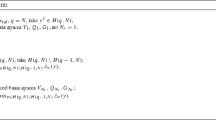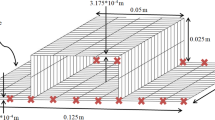Abstract
In this paper, the compensator based reduced order control design framework of Burns and King (J. Vibrations and Control, vol. 4, pp. 297–323, 1998) is modified to yield low order systems with guaranteed stability margins. This result is achieved through use of a logarithmic barrier function. In addition, a reduced basis method is formulated in which the compensator equations are approximated on uneven grids; guaranteed stability margins are also included. The methods are tested numerically on a one dimensional, nonlinear, damped, hyperbolic structural control problem. Examples are provided to illustrate differences between systems designed by both reduced basis methods.
Similar content being viewed by others
References
T. Başar and P. Bernhard, H ∞-Optimal Control and Related Minimax Design Problems, Birkhäuser: Boston, 1991.
J.A. Burns and B.B. King, “Optimal sensor location for robust control of distributed parameter systems,” in Proceedings of the 33rd IEEE Conf. on Decision and Control, Orlando, FL, 1994, pp. 3967-3972.
J.A. Burns and B.B. King, “A reduced basis approach to the design of low order compensators for nonlinear partial differential equation systems,” J. Vibrations and Control, vol. 4, pp. 297-323, 1998.
P. Dorato, C. Abdallah, and V. Cerone, Linear-Quadratic Control, An Introduction, Prentice Hall: Englewood Cliffs, 1995.
M. Fahl and E.W. Sachs, “Modern optimization methods for structural design under feasibility constraints,” Computational Methods for Optimal Design and Control, J. Borggaard, J. Burns, E. Cliff, and S. Schreck (Eds.), Birkhäuser: Boston, 1998, pp. 137-150.
A.V. Fiacco and G.P. McCormick, Nonlinear Programming: Sequential Unconstrained Minimization Techniques, vol. 4, SIAM: Philadelphia, 1990. Reprint: SIAM Classics in Applied Mathematics.
B.B. King, “Nonuniform grids for reduced basis design of low order feedback controllers for nonlinear continuous systems,” Mathematical Models and Methods in Applied Sciences, vol. 8, No. 7, pp. 1223-1241, 1998.
B.B. King, “On the representation of feedback operators for parabolic control problems,” Proc. of the AMS, vol. 128, No. 5 (2000) 1339-1346.
B.B. King, “Representation of feedback operators for hyperbolic partial differential equation control problems,” Universität Trier Mathematik/Informatik Forschungsbericht Nr. 96-43.
B.B. King and E.W. Sachs, “Optimization techniques for stable reduced order controllers for partial differential equations,” in Optimal Control: Theory, Algorithms, and Applications, W.W. Hager and P.M Pardalos (Eds.), Kluwer Academic Publishers B.V., Dordrecht, 1998, pp. 278-297.
B.B. King and E.W. Sachs, “Semidefinite programming techniques for reduced order systems with guaranteed stability margins: A numerical study,” Virginia Tech ICAM Technical Report 98-10-01.
P. Lancaster and L. Rodman, Algebraic Riccati Equations, Clarendon Press: Oxford, 1995.
F. Leibfritz, “Logarithmic barrier methods for solving the optimal output feedback problem,” Universität Trier Mathematik/Informatik Forschungsbericht Nr. 95-16.
H. Marrekchi, “Dynamic compensators for a nonlinear conservation law,” Ph.D. Dissertation, Virginia Polytechnic Institute and State University, 1993.
C. McMillan and R. Triggiani, “Min-max game theory and algebraic Riccati equations for boundary control problems with continuous input-solution map. Part I: The stable case,” in Evolution Equations, Control Theory and Biomathematics, P. Clement and G. Lumer (Eds.), Marcel Dekker: New York, 1993, pp. 377-403.
C. McMillan and R. Triggiani, “Min-max game theory and algebraic Riccati equations for boundary control problems with continuous input-solution map. Part II: The general case,” Applied Mathematics and Optimization, vol. 29, pp. 1-65, 1994.
A.H. Nayfeh, J.F. Nayfeh, and D.T. Mook, “On methods for continuous systems with quadratic and cubic nonlinearities,” Nonlinear Dynamics, vol. 3, pp. 145-162, 1992.
K. Oates, “A study of control system radii for approximation of infinite dimensional systems,” Masters Thesis, Virginia Tech, 1991.
I. Rhee and J.L. Speyer, “A game theoretic controller and its relationship to H1 and Linear-Exponential-Gaussian synthesis,” in Proceedings of the 28th IEEE Conference on Decision and Control, Tampa, FL, Dec. 1989, pp. 909-915.
U. Ringertz, “Eigenvalues in optimum structural design,” Technical Report 96-8, KTH, Stockholm, Department of Aeronautics, 1996.
L. Vandenberghe and S. Boyd, “Semidefinite programming,” SIAM Review, vol. 38, pp. 49-95, 1996.
B. van Keulen, H ∞-Control for Infinite Dimensional Systems: A State Space Approach, Birkhäuser Inc.: Boston, 1993.
Author information
Authors and Affiliations
Rights and permissions
About this article
Cite this article
King, B.B., Sachs, E.W. Semidefinite Programming Techniques for Reduced Order Systems with Guaranteed Stability Margins. Computational Optimization and Applications 17, 37–59 (2000). https://doi.org/10.1023/A:1008727108728
Issue Date:
DOI: https://doi.org/10.1023/A:1008727108728




